
|
Note ye ed's email address: stevebryant99@gmail.com. |

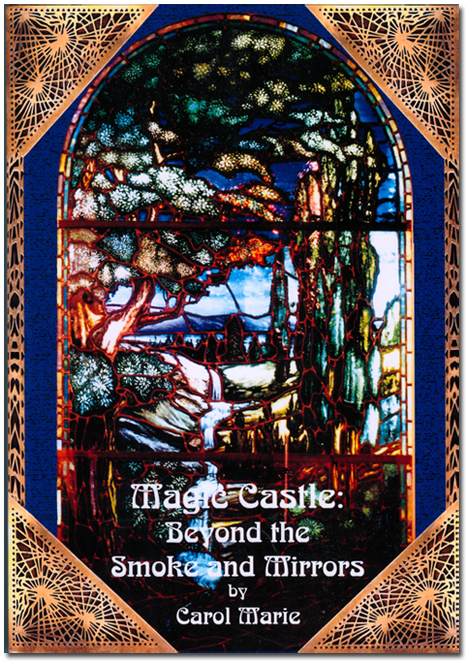
Ultimate Magic Castle tour guide.
|
Last month's May issue considered John Bannon's lecture notes Lucky., The Magic Depot's Deck of Slates, and TV horror meister Zacherley. |
June 2017 Here comes summer! I look forward to seeing some of you in Louisville, to hoist a glass to Mac King and Lance Burton. Meanwhile, we'll use what's left of June here to consider Bob Farmer's amazing new card system, to some serious innovation from Andy at The Jerx, and to a rejuvenated tour of the Magic Castle from Milt Larsen and Carol Marie. Arrived too late to review but too important to overlook: Illusions, The Art of Magic, essays and photos of the Allan Slaight poster art collection. Gorgeous all in black with gold detail and worth far more than the $32 Amazon is charging. Carpe diem! I mention below a fondness for all things Disney, and I'll close with a photo of Taschen's new The Walt Disney Film Archives: The Animated Movies 1921-1968. A whopping 16.5 by 12 in. On my regulation card table it opens so wide that it doesn't fit. Still looking for a shelf that can accommodate it. |
|
|
ASSORTED ACTS -- Isn't it amazing how much fun we can have with a deck of cards? Lately, Bob Farmer has been having fun and sharing the wealth via his new book (plus follow-up addenda), The Bammo Tarodiction Toolbox. He has discovered a new principle for secretly coding a group of playing cards such that they can be spectator-shuffled and then quickly unshuffled back into a useful sequence, such as an Aronson or Tamariz stack. The first time you attempt this--and the book opens with a five-card example--should thrill you. It feels like magic. How does the deck know the precise steps to follow to unshuffle itself from 52 factorial possible arrangements (a very large number)? Various practical magic tricks emerge. Consider Triharder: Spek shuffles two packets of 15 cards, gives you either one. You then deal your packet three times into three piles as the spek duplicates your actions. You get a straight flush and two royals in order; spek gets only three so-so hands. Tell him to try harder! 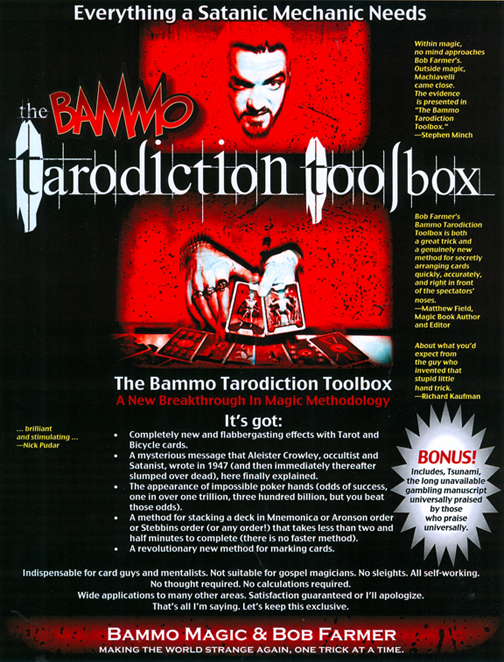 Bob Farmer dives into math. You can perform magic, or you can use the system at home to stack decks into your favorite arrangements, fast. A nodding acquaintance with binary and other based number systems is helpful but not necessary. (Longtime readers may recall Richard's Stack, from the September 1996 Little Egypt Gazette. That required you to convert a stack position from decimal to octal, to reverse the digits, and then back to decimal to determine a card's value; now that was tricky, on the fly.) Part One explains the system, and Part Two explains the math. More precisely, Part Two explains how to do the math. But I was frustrated that I couldn't put into words why the math worked. How could a deck unshuffle itself from a random shuffle? It feels quite magical when you see it work. For an answer, I turned to my San Diego friend Jim Held, a non-magician Caltech grad, who explained it in a way I could finally grasp. Parenthetically, Jim was a classmate of the guy who gave us Richard's Stack and has helped us here before with the algebra that explains Dai Vernon's Affinities (December 2006). Here is his response, and it should only make sense to you after you study Bob's system: "I don't think this is as complex as it seems. You can sort a group of cards by any set of characteristics. In this case the sort is by means of significant digits. In the case of using trinary and up to 27 (3 cubed) cards using 000 thru 222, you can first put the stack in order of 'most significant digit' then 'next most' and then 'least.' This will produce a unique result, depending on how you choose to stack the sorted piles. To see how simply you can do a sort like this, imagine this: Take the A, K, Q, J of each suit (16 cards)... 4 sets of 4 cards. Since there are only 2 characteristics (suit and denomination) you need only two cycles of 4 stacks. First sort by suit into 4 piles. Then sort by denomination into 4 piles. The cards will be sorted into a unique order depending on how you pick up the stacks. If you do it in the most logical order you will get AKQJ of each suit in SHDC order. To me, all of these methods are just variations of the simple example I have given. The marking of the cards just allows you to make the trick look more complicated and harder to see what's going on." The key to my understanding the above is to change my verb "unshuffle" to "sort." Sorting has been Bob Farmer's gift for some years, as Part Three of the book testifies: a reprint of Tsunami. The original Tsunami ranks among my all-time favorite ad copy, part Casablanca, part Indiana Jones, part Terry and the Pirates.  My original copy of Tsunami, printed on red paper. The core effect allows a spek to think of any card he sees in a mixed deck, after which the magi bets some money and begins making statements. If he is correct, he adds to the pot. If he ever misses, all the money goes to the spek, but wait: the magi gets one last chance to identify the card. He does. There are numerous variations on the theme, including impromptu versions that exploit Bob's Pentacle Force and most involving the principle of concealed distribution. Sorting again. A personal note: when Tsunami first came out, I was smitten by a Tim Conover trick in it and performed it every chance I could. It was my first exposure to that method, and it (along with Paul Harris's Deep Astonishment) fooled my audiences as badly as anything else I have attempted. This book is as much fun as, say, a new Harry Lorayne book. It is full of things you will want to try. Some arts and crafts are involved if you want to perform the Tarodiction effects. (For an example check Bob's "Marxism & Magic" in his Flim-Flam column in MAGIC, October 1996.) The Tsunami effects require no gaffing. The book is spiral bound, which in my case made the math a tad tricky. (Five sheets had been inserted out of order. Not a problem; this is, after all, a book on sorting.) An extra sheet came with the book, and several addenda have arrived so far by email. I expect more, as this is a whole new ball game in card magic, still evolving. $35, 100 pages. Email order to Bammomagic@cogeco.ca. |
|
|
AND NOW FOR SOMETHING COMPLETELY DIFFERENT -- We've discussed The Jerx here before, and its e-zine JAMM. In case some of you who didn't subscribe are wondering how it's going, I say fabulously! A subscription to JAMM ($120 a year, twelve issues plus bonus stuff) subsidizes The Jerx itself (an invariably interesting blog that publishes three times a week), provides readers with truly groundbreaking new material (see below), and gives publisher Andy an excuse to persuade old and new female friends to pose as JAMM muses. So it's win-win-win. I am motivated to mention it again because of two stellar tricks in the past two issues. JAMM 04 gives us Sunlight Bumblelily, a card revelation that credits real fairies, and JAMM 05 gives us the most memorable card routine since Arthur Monroe's Voodoo, attributed to St. Anthony, the patron saint of lost things. 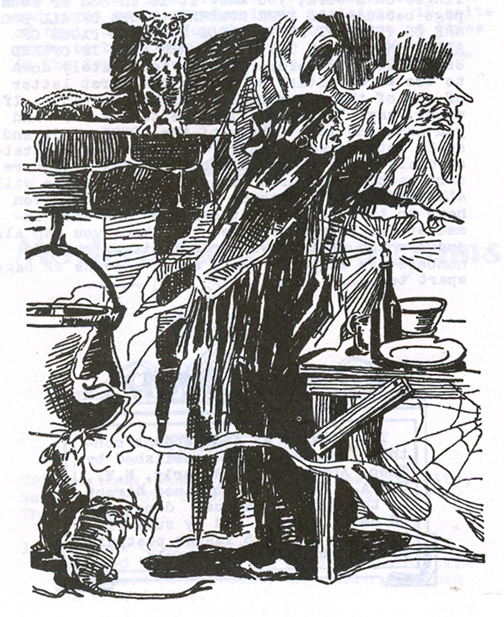 Original illustration for Voodoo, The Jinx, May 1937. I know, I know, you may not be into fairies. Fret not; the heart of the routine is a general purpose card (or word or physical object or whatever) revelation that is perhaps the most charming you have ever imagined. For a small fee ($11) you can also highly personalize it, leaving that special someone (a girl you wish to impress, the CEO of your client, the bride at a wedding, etc.) with a treasured momento. Almost any routine can feed into the revelation, but Andy prefers one that is deadly baffling (coincidentally, one that I mentioned in the Tarodiction report). The St. Anthony routine transpires partly in candle light, partly in pitch darkness. It is that staging that reminds me of and begs comparison to Monroe's Voodoo, but it is also a devilishly constructed new effect that features clairvoyance along with two spirit messages that morph into the location of and the substance of something the spek lost and has drawn a picture of -- in the dark. Thank you, St. Anthony. 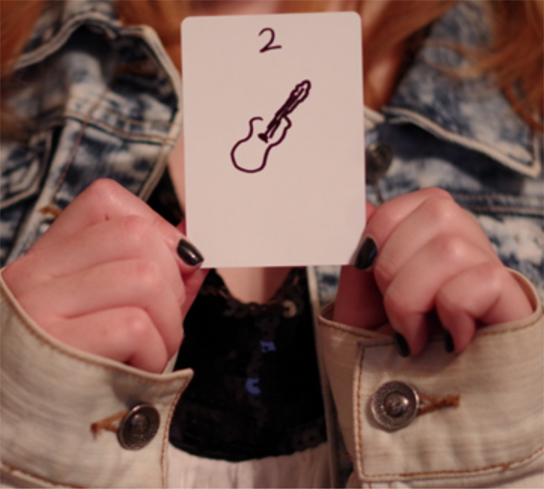 Can St. Anthony find this girl's guitar? I am itching to perform both these routines. It has been a while since a material-based magazine has excited me as much as JAMM, and I hope Andy's secrets remain confined to his subscribers. Meanwhile, JAMM has me thinking. Perhaps Little Egypt Magic needs some muses. Pharaoh girls? |
|
|
IT'S ALMOST LIKE BEING THERE -- I love Walt Disney World and Disneyland but get there far too rarely. To compensate, I enjoy reading about the place, not only in the Birnbaum-level guide books, but in more ambitious books and journals. Favorites that have not been shoved off the shelves by my magic collection include Walt Disney Imagineering (1996 and 2010); Poster Art of the Disney Parks; Jason Surrell's The Disney Mountains, Pirates of the Caribbean, and The Hunted mansion; The Unauthorized Story of Walt Disney's Haunted Mansion (Jeff Beham); and journals Disney twenty-three and The E Ticket. New as of Fathers Day 2017: A Historical Tour of Walt Disney World (Andrew Kiste). I feel the same about the Magic Castle. Love to be there, but reading about it softens the ache of absence. Long favorite books include Milt Larsen's Magical Mystery Tour of Hollywood's Most Amazing Landmark The Magic Castle (written and photos by Carol Marie) with its sepia tinted photos of every nook and cranny (1997) and Hollywood Illusion: Magic Castle (Milt Larsen) with Milt's personality-driven history of his pet project. Castle stories and photos enliven Milt's autobiography My Magical Journey, and there are warm reminiscences in The Vernon Touch (Dai Vernon), Tales from the Uncanny Scot (Ron Wilson), and The Vernon Companion (Michael Perovich) along with the many cartoon images of Nielsen Magic's The Magic Castle's Walls of Fame. Early influences were the souvenir book The Magic Castle and the January 1965 issue of Genii. I visited the Castle in 2002 to do a Genii story on its spooky side, and editor-by-then Richard Kaufmann realized the Castle was soon turning 40, so we combined the story and ran 34 pages on it. Today, Daniel Ulin continues to spread Castle news via his monthly Genii column. 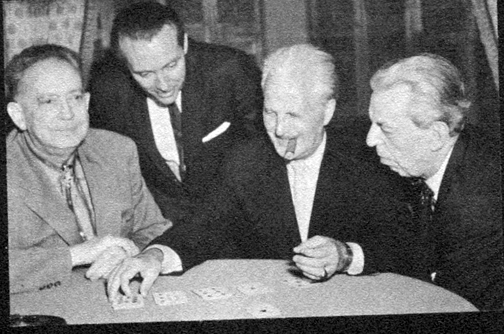 Castle magicians in the January 1965 Genii. The newest book for Magic Castle aficionados is Magic Castle: Beyond the Smoke and Mirrors by Carol Marie. The 1997 edition of the tour book mentioned above became out of date after the post-Halloween fire of 2011 and subsequent alterations to the Castle. Carol marie, whose photos and text created the original from Milt's walking tours, stepped up again and not only brought the depictions up to date but completely revitalized the book itself with 300 glossy pages and all the photos sharp and in full color. It's a lovely book to lose yourself in, and don't you love the title? It has been a while since I visited the Castle, and I look forward to ticking off all the updates, including a rainbow display of portraits of the founders and friends who breathed life into the Castle in the early days, a sampling of caricatures by Jim Steinmeyer, and a likeness of Cary Grant in an art glass window.  Your table is ready. Come on up! Carol Marie has long been Milt's (and the Magic Castle's) Boswell, and this may be her finest work yet. Huge thanks to her and publisher Don McCoy for making this work available. $30 soft cover, $50 hardback. Available at Amazon. I bought mine from H&R Magic Books. 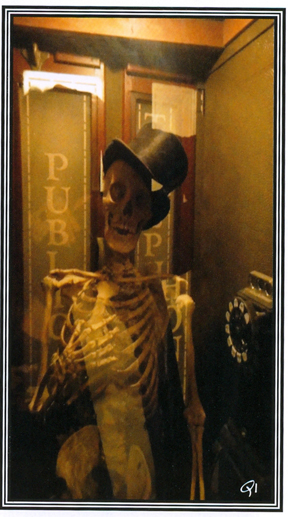 Step into the phone booth, and you might not be alone! 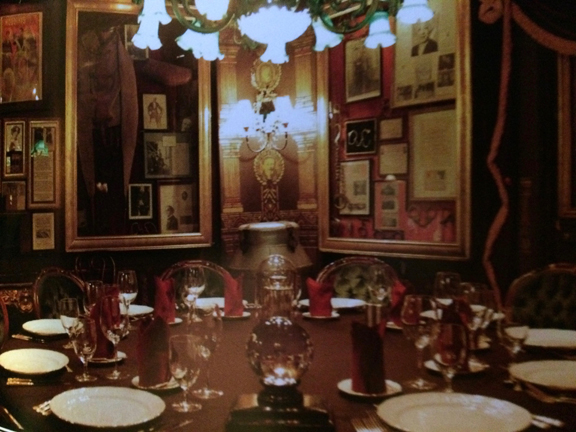 I've seen ghosts in this room.  Steve, put your hand here! Last week Drew Barrymore sat on this stool.
|
 Movie magic: the films Walt himself supervised.
Aloha, Adam West.
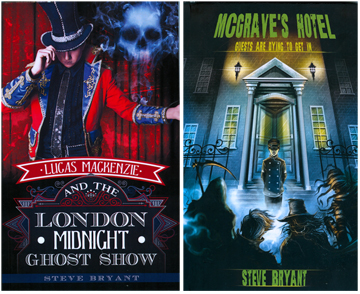
No finer summer beach reading anywhere: McGrave's Hotel and Lucas Mackenzie and The London Midnight Ghost Show.
Little Egypt Magic is the erratically updated web site of Steve Bryant, spawned (the site, not Steve) by a former internet magazine known as The Little Egypt Gazette/for magicians only. Steve Bryant is an obscure magician and writer who generates this site from an iMac in Bloomington, Indiana. He used to frequently journey to and perform magic in Little Egypt, the local name for extreme southern Illinois, where the towns bear such names as Cairo, Thebes, and Karnak. Past issues of this web site: Index to Past Issues Notice: Any limited use of copyrighted images or quoted text is considered fair use, usually to review whatever product or event that is under discussion. If you object to use of any material, please get in touch and it will be cheerfully removed. |
A JSB Creations product
Copyright© 2017 by Steve Bryant